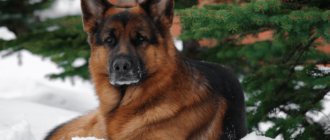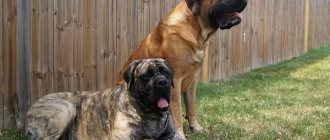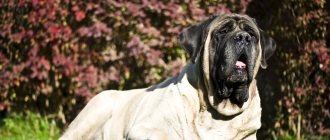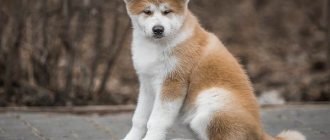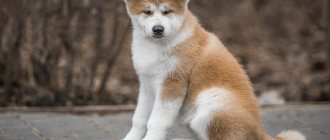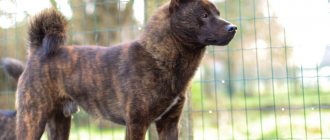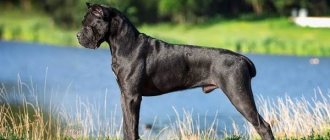The Sheltie dog breed has an elegant and luxurious appearance. The origin of this breed is quite vague and has several versions. But we can definitely say that their homeland is the island of Shetland, which is located in the northeastern part of Scotland.
Initially, Sheltie guarded small sheep, but over time there was no need for their protection. Nothing bad happened, thanks to their friendly, intelligent disposition, they became a wonderful human companion. This breed is distinguished by symmetry of proportions, beautiful coat color and charming character. In short, it turned out to be a wonderful companion dog.
Features and description
These are very brave and strong shepherd dogs that get along well not only with livestock, but also with people. The second name of the breed is Shetland Sheepdog, with an “e”, since the breed appeared on the Shetland Islands. She is the smallest among the four-legged shepherds and, perhaps, the most charming.
Sheltie, one of the smallest herding dogs
In Scotland, this animal was used to look after a small herd of cows or sheep. Also, the dog often had to protect chickens and ducks. The development of the agricultural sector in the world led to the almost complete disappearance of the breed. Shelties were replaced by larger and braver shepherd dogs. But, fortunately, these charming dogs have fans who did not let them disappear.
People who liked the cute and efficient Shetland Sheepdogs began to actively select them. As a result, representatives of the breed quickly spread throughout the world. No one can say which dogs' genes were most likely used to breed these dogs. But even an inexperienced breeder will say that to breed modern Shelties, professionals probably used collie and Spitz genes.
Today, these wonderful dogs are rarely used for farm work. They are more valued as comrades and companions. The Sheltie is an ideal family pet. She is kind, affectionate, and good at communicating.
Breeders of this breed advise starting it with a pensioner who has been deprived of attention. Practice proves that interaction with a dog improves mood and well-being. This pet is also suitable for large families. He gets along with children of different ages and genders.
Sheltie finds a common language with all pets living in the house and children
You shouldn’t count on a Shetland Sheepdog to guard your apartment. Yes, it can be trained so that it begins to react to the arrival of strangers. But this cute beast will not harm anyone.
Origin story
There is no reliable information about when and by whom the first Sheltie dogs were bred. But among dog handlers, the two most plausible versions are in circulation:
- The breed is native. The Shetland Islands became the historical homeland of the animals. Nomadic peoples, looking for new territories for herding sheep, brought Scottish shepherd dogs with them to the islands. Subsequently, they were crossed with local Scandinavian Spitz and a new species was obtained. Outwardly, the breed more closely resembled Spitz dogs, but at the beginning of the 20th century, individuals were mixed with a long-haired collie, as a result of which the Sheltie's exterior changed.
- Descendants of the Border Collie. This statement is also based on the resettlement of nomads, but with the difference that the Sheltie’s ancestors were not Spitz dogs, but Scottish border collies.
In addition, experts suggest that the Sheltie gene pool was formed with the participation of King Charles Spaniels and other continental breeds. The time frame for the formation of the species is outlined by the 9th–14th centuries.
The main purpose of the dogs was shepherding service. The small, but nimble Scottish Sheepdog Sheltie skillfully coped with the rutting sheep, deftly urging animals that lagged behind the flock. However, in the 19th century, British breeders developed new, larger varieties of livestock. The intelligent, but almost dwarf Sheltie dog could do little to oppose the massive sheep, except for a ringing bark and light biting. As a result, the herd did not listen and wandered randomly.
Miniature dogs were replaced by large types of shepherd dogs, and the Sheltie breed fell out of favor. The population was rapidly thinning, almost on the verge of extinction. Local enthusiasts, led by experienced breeder James Loggie, decided to save the Shetland dogs. By that time, Shelties began to be kept as ordinary pets, and it was decided to make excellent home companions out of the former shepherds. To do this, they tried to standardize the species of individuals, endowing the offspring with selected genes.
They wanted to call the revived breed Shetland Collies, but Scottish Collie breeders opposed this decision. Due to the similarity of names, there could be confusion in the breeds, so we had to take the indignation of our colleagues into account. Based on its main habitat and in honor of its original purpose, the updated species was named Shetland Sheepdog or Sheltie for short.
The population began to grow, which was facilitated by the creation of the Scottish and English Sheltie clubs (1909 and 1914). Around the same time, several representatives of the breed were exported overseas, and in America, mini collies instantly won the sympathy of the public. And after another couple of decades, the breed achieves the honor of being officially recognized. In 1948, the English Club created a standard description of the breed for Sheltie, which would later be used as a basis by other cynological federations.
Related article:
Small dog breeds - top 35 breeds with photos and brief descriptions. It may also be interesting to read a list of the smallest dog breeds with photographs and a brief description of their characteristics.
Breed standard
The Sheltie dog is small and agile. She is completely uncharacteristic of clumsiness. The height of an adult at the withers is from 34 to 38 cm. Males are several centimeters taller than females. If a dog's height is higher than this mark, it cannot be considered a purebred.
A shepherd dog weighs from 5 to 8 kg. It is folded harmoniously. Every part of her body looks great when combined with the rest. The dog has an elongated rectangular body, a fairly wide back, and a strong, neat neck.
The animal's legs are set parallel and have lean muscles. Very strong, short. The joints on the paws are strong. The dog's sternum deepens to the elbow joints. The bulge is clearly visible on the lower back. There is an excellent arch in the rib area. The shepherd's tail is set low. It bends slightly upward, but is almost invisible due to the lush fur. According to the standard, it cannot be broken.
From shepherds, Shelties have become loyal friends and companions.
These wonderful animals have a graceful gait. They move smoothly and slowly, preferring to remain calm in any situation. The dog's head is small and its muzzle is elongated. Her ears are located close to each other. Medium in thickness and pointed at the tips.
The occipital protuberance is practically invisible on the head. The cheeks are slightly sunken and flat. There is pigmentation in the area of the nose and lips. The dog's slanting tiny eyes are almond-shaped in shape. The color of the iris is brown or black.
Interesting! Some representatives of the breed are born with heterochromia. This is a specific phenomenon consisting of the presence of different colored eyes. For example, an individual may be born with a blue and a black eye.
The Sheltie in the photo is depicted as interested, attentive and observant. Perhaps this is due to the small and slightly sunken eye sockets, but, rather, this image is an indicator of the dog’s character. According to the standard, her jaw should be symmetrical. Well defined chin. The bite is scissor-shaped. The teeth are sharp and white. There should be 42 of them.
The fur of such dogs is luxurious. It should be shiny, a little stiff and long. High-breed Scottish Sheepdogs have the longest fur on their necks. This makes the dog seem like a lion, as it has a “mane.” But on the muzzle it is short.
Health
Characteristic diseases
Congenital anomalies, allergies and cataracts are practically not found in this breed, but these dogs are susceptible to several serious diseases:
— bladder cancer is the main cause of early deaths in this breed, diagnosed by regular testing;
- dermatomyositis - a disease of Sheltie puppies, manifests itself in damage to the skin, without proper treatment leads to significant disorders of the nervous system;
- von Willebrand genetic pathology - cannot be treated, dogs with this disease are euthanized in the first months of life;
— violation of the hip joints is a congenital defect that requires surgical correction.
The Sheltie dog breed is suitable for living in a home, but the overflowing energy of a pet can harm the apartment if it is not given the opportunity to run and frolic, like Greyhound dogs. To do this, you should regularly walk the animals.
Kinds
The Sheltie breed was standardized once, so its varieties are not distinguished. However, these wonderful shepherd dogs can be classified by color. Possible options:
- Black-red-white (more common than others).
- White black.
- Blue-red-white (blue morel).
- Sable.
High-breed representatives are united by the presence of a large white spot on the sternum. There may also be light markings on dogs' paws and faces. Their presence in these areas is preferable. But reddish-brown spots on the Sheltie’s body are extremely undesirable.
Character
Experts insist that the Shetland Sheepdog is one of the best companion dogs. She loves the people around her very much, quickly becomes attached to them, and is always nearby. This is an incredibly gentle creature who is always ready to share her love with others. It can gently rub its head against its owner's hand, begging for his attention. In response to affection, he wags his tail cheerfully.
The dog is very friendly. Rancor is not characteristic of her. He always warmly welcomes guests, does not get angry and does not rush at any of them. Even drunk people do not cause negative emotions in Shelties. If the dog understands that a particular person is inadequate, he will not interact with him, but will simply move away.
A shepherd will always find a common language with a child, because she is very sociable. Regardless of age, such a dog will definitely enjoy playing with the baby. All herding dogs are good house sitters, and Shelties are no exception.
Sheltie is often considered a small collie, but they are completely different breeds of dog in their own right.
Strangers may be viewed with distrust, especially if they do not interact with others respectfully. They have an extremely negative attitude towards anger, manifestations of aggression of any kind, screaming, etc. Such a dog is deeply hurt by someone else’s abuse, since by nature it is very vulnerable and sensitive. But she herself is rarely offended.
However, even such a cute dog is capable of vanity. No, his self-esteem is not inflated, it’s just that a beautiful animal knows his worth and will not allow him to be treated without respect. He needs not only care, but also support, adequate assessment and even admiration. Praising your beloved owner will make him very happy.
Interesting! The Shetland Sheepdog can make many interesting sounds. And her “arsenal” includes bird chirping, cat purring and barking typical of dogs. It can be either noisy or quiet, depending on your mood.
Care and maintenance
A small herding dog needs frequent exposure to nature, preferably near farm animals. But it cannot be said that life in an apartment will seem boring to the Sheltie. If you, living in a small room without access to the yard, want to get such a dog, we also recommend that you “settle” other animals on your territory: cats, birds, lizards, turtles, etc.
The dog will definitely find a common language with any pet. But you need to communicate with him in their presence correctly. It is important that he does not become jealous of his owner towards other living creatures. Therefore, you should not deprive him of attention.
When caring for a shepherd, special attention should be paid to its coat. It is rather harsh and long, so it needs regular cleaning and combing. For silk, you can choose a comb with stiff bristles or a massager with elongated teeth. A representative of this breed sheds in the warm season, mainly in summer.
If such a dog is not combed, long tangles will form all over its body. In this case, his coat will lose its presentable appearance. He doesn't need frequent bathing. We recommend choosing good healthy shampoos.
Also, do not forget to clean your pet:
- The eyes are sour.
- Teeth from plaque.
- Ears from wax.
Nutrition
A Sheltie puppy be fed differently than an adult representative of the breed. Until it is fully formed, you need to help its body enrich itself with useful substances: calcium, vitamins A, B and C, zinc, iron, bacteria for digesting food, etc.
A commercial diet is indicated only for adult Shetland Sheepdogs whose bodies are already fully developed. Kids should be given: cottage cheese, boiled eggs, meat products, milk, fresh fruits, boiled potatoes, fresh vegetables and berries. It is worth limiting its consumption: pasta, fatty meat broths, chocolate, smoked meats and baked goods.
Important! Giving such a dog sharp bones, as well as meat that may contain them, is strictly prohibited.
You can also treat your puppy to low-fat boiled fish, beef, broccoli, mushrooms or soups. Among flour products, he is allowed the following semi-finished products: homemade dumplings and dumplings, pancakes, pizza. But don't let your pet eat too much flour products, because they increase gas formation in the stomach.
Sheltie dog care
In order for a pet to please its owners and be a worthy representative of the breed, it must be properly cared for.
Feeding
The basis of the diet is animal protein obtained from raw meat or sea fish. You also need to give your dog fermented milk products, boiled eggs, fresh fruits and vegetables, and berries. Treats with greens (parsley, dill, lettuce) are welcome. Absolutely should not be in a dog's bowl:
- sweets;
- smoked meats;
- flour products;
- legumes;
- pickles;
- sharp bones.
Only an adult Sheltie can eat dry food - the puppy needs to be raised on natural food.
Hygiene procedures
In terms of hygiene, you need to regularly brush your pet’s teeth and ears, trim its nails, bathe and comb it.
The Sheltie breed is a long-haired dog, so caring for its coat is difficult. The animal is regularly combed 3-4 times a week (daily during the molting period). For the procedure, use a comb with long and frequent teeth - this method of combing prevents the formation of tufts. But the fur of shepherd dogs is not susceptible to dirt, so they bathe pets 1-2 times a month. When washing, it is advisable to use dog shampoos and conditioners. Upon completion of the procedure, you should dry the hair with a hairdryer.
Maintenance and walking
The Sheltie's modest size makes it possible to keep dogs in city apartments, but these are not the pets that are happy to lie on the sofa all day long. The natural character traits of the Sheltie dog attract it to an active lifestyle.
An adult needs to spend at least 2-3 hours outdoors, playing and improving his physical fitness. Puppies are walked for 30 minutes three times a day, depending on weather conditions. The chilly cold and walking on icy paths are harmful to the baby. Up to 3 months, the pet should be carried down stairs by hand to avoid curvature of the croup.
Health
Sores rarely occur in a breed of dog such as Sheltie. But an incorrect lifestyle can cause obesity, joint problems, and eye diseases. Sometimes individuals are born with congenital deafness or a hereditary blood disease.
Related article:
Thai Ridgeback – characteristics of appearance and temperament, care features. In a separate article on our website you can get acquainted in more detail with the rare in Russia, but very interesting Thai Ridgeback breed.
Reproduction and lifespan
Shelties are charming shepherd dogs with sociable inclinations and a good disposition. They are smart, loyal and sociable. Every breeder knows how to distinguish a purebred representative of the breed from an ordinary fluffy mongrel. There are a number of signs by which he can do this:
- The Shetland Sheepdog's coat should be shiny, long and rough to the touch.
- There must be a light mark on her sternum.
- The tail of such a dog should be low and hang down evenly, and not lie on the back in a “ring”.
- There are 42 teeth in her mouth.
- There are no dewclaws on the front paws.
When a Sheltie bitch is in heat, the breeder should monitor her mood and well-being. He must wait until the 4th day of her menstruation and then go with her to the male dog's house. He will definitely sniff the female, after which he will demonstrate to her his interest in mating.
She, in turn, can accept his advances, or push him away. In the second case, their meeting will have to be rescheduled for another day. Life expectancy with proper and timely care is from 14 to 16 years.
Key points in training
Raising a Sheltie is not difficult; even a beginner can handle it. Thanks to their great desire to please their owner, little collie clones will show remarkable obedience. Even children can train Shetland Sheepdogs.
Professional trainers can hope to win prizes in training competitions. Shelties can successfully run agility courses, win in dog frisbee, freestyle, and obedience. Only competitions that include tests of guarding qualities are not suitable for small shepherds.
Read about how to properly train a dog in the article: “Training a puppy: effective methods from dog handlers, learning commands at home.”
Only humane training methods are suitable for Shelties..
When corrective equipment or harsh punishment methods are used, the dog can become intimidated and angry. Contact with the trainer will be lost and will have to be restored for a long time.
Price
Today, there are nurseries for cute shepherd dogs in almost every capital of the CIS - Kyiv, Moscow, Minsk, etc. In Russia they are very loved and pampered.
Also, anyone can purchase a pedigree for an animal. The Sheltie price for 2022 ranges from 20 to 35 thousand rubles. Low-breed dogs from private breeders are sold cheaper, about 15 thousand rubles.
How to choose a puppy
Initially, you need to check all the documentation confirming the origin of the baby.
Average prices for Sheltie dogs range from 20-40 thousand rubles. If you are not taking a dog to participate in competitions, and small deviations from the breed standards are acceptable, you can purchase it much cheaper.The best way to predict what he will be like when he grows up is to meet his parents; nurseries always provide this opportunity. Decide in advance on the gender of your future pet, given that males are more difficult to train.
Education and training
Sheltie, one of the smart and kind breeds, is a pleasure to raise. Experts say his mental abilities are similar to those of a 3-year-old child.
Such a dog needs to be raised very gently. She will never become disciplined if she is afraid of you. Hitting an animal is prohibited! Use exclusively the carrot method in his upbringing, or rather gentle persuasion, encouragement and reward.
As punishment - only verbal punishment. But remember, those who do not tolerate Sheltie screaming. Loud noises frighten gentle dogs; they become cowardly and unsure of themselves if they live in an atmosphere of abuse.
What should you teach such a dog first?
- Come when called.
- Do not climb onto the dining table and beg for food.
- Do not shit in the house, but relieve yourself only on the street.
- Make friends with other pets, as well as with children.
- Notify the owner of the arrival of guests to the house.
- Behave appropriately while walking.
The Sheltie is easy to train and easy to train.
The Shetland Sheepdog is very inquisitive. Excessive curiosity often makes her break out into the street in order to rush forward faster. This cannot be allowed. Remember, the animal should walk next to you when you lead it on a leash and under no circumstances pull it forward. The best “cure” for this kind of behavior is a strong tug with the leash.
Pros and cons of the breed
Before purchasing a Shetland Sheepdog, the future owner must be aware of the responsibility, so it is recommended that you familiarize yourself with the advantages and disadvantages of this breed.
Pros:
- a wonderful family friend;
- knows how to obey and is easy to learn;
- is suitable and needs to live at home or in an apartment;
- gets along with children and other pets;
- fits into the active lifestyle of the owner.
Minuses:
- not suitable as a security guard;
- needs special coat care;
- there is a predisposition to certain diseases;
- not suitable for a passive lifestyle.
The Sheltie becomes very attached to its owner and has a hard time with separation. Having assessed the pros and cons of the future, the owner will be able to understand whether he is ready to have such a pet and provide him with everything necessary.
Possible diseases and methods of treating them
Shelties have strong immunity. They move a lot and therefore hardly get sick. However, some representatives of the breed still end up at the veterinarian. Possible diagnoses:
- Hip dysplasia. Often diagnosed as a mature Sheltie.
- Allergy to food. Occurs only when the animal is not fed properly.
- Epilepsy. Congenital pathology, often found in males.
If your pet constantly scratches its eyes or ears, it may have an infection. After a medical examination, you will have to instill a special medicine into his mucous membranes. You cannot prescribe it yourself!
Remember, healthy Shelties are active, lively and curious. It is easy to understand that the dog is sick. Firstly, she will sleep a lot, and secondly, she will lose her appetite. In this case, take her to the vet.
Common diseases
Thanks to their strong immunity and great mobility, Shelties rarely get sick. However, sometimes you still have to visit veterinarians.
The first signs of disease in nimble representatives of the breed are immediately noticeable: Sleeps for a long time and eats poorly. See a doctor immediately if the dog is not frolicking and is not interested in its surroundings.
What diseases is this breed susceptible to?
- Eye diseases - cataracts, corneal dystrophy. After being examined by an ophthalmologist, if diagnosed early, the dog will recover. If a retinal detachment occurs, the dog may go blind.
- Hearing problems are rare, unless it is a congenital disorder.
- Skin diseases. Due to skin sensitivity, dermatitis and dermatomyositis may occur. Even a small wound that is not treated promptly can cause a serious illness.
- Joints. The problem with this breed is rapid wear of joints and dislocations. Often this can only be corrected with surgery. Be careful when walking, there are no genetic problems, and the dog will not suffer from joint pain.
Vaccinations and visits to the veterinarian will protect your miniature pet from disease.


